Gravel bikes stand out in the cycling world for their incredible versatility. They’re not confined to a single path, purpose or riding style. We’ve rigorously tested everything from speed-focused, aerodynamic gravel machines to robust steel-framed bikes equipped with mountain bike tires and suspension. This adaptability is what makes gravel bikes so appealing; you can customize them to match your on and off-road preferences. Beyond racing and weekend adventures, they excel in various roles, including commuting, bikepacking and touring, cyclocross racing, and even road riding.
So, what truly defines the best gravel bikes? Whether you’re aiming to conquer challenging bikepacking routes or tackle demanding gravel races, we have a gravel bike recommendation for you. Each bike featured below has undergone thorough testing by our team of expert reviewers.
If you’re new to cycling or gravel riding, and the bikes presented here seem a bit high-end, we encourage you to explore our guide to the best budget gravel bikes for more affordable options.
Quick Picks: Top Gravel Bikes at a Glance
 Giant Revolt Advanced Pro gravel bikeThe Giant Revolt Advanced Pro, our best overall gravel bike pick for 2024. 1. Giant Revolt Advanced Pro
Giant Revolt Advanced Pro gravel bikeThe Giant Revolt Advanced Pro, our best overall gravel bike pick for 2024. 1. Giant Revolt Advanced Pro
Best Overall Gravel Bike
The Giant Revolt Advanced Pro, our Gravel Bike of the Year for 2023, has consistently proven its exceptional capabilities. Its compliant seat post and comfortable carbon frame effectively dampen vibrations, while the adjustable rear dropout allows for geometry fine-tuning to match diverse terrains and rider preferences.
Explore the Giant Revolt Advanced Pro
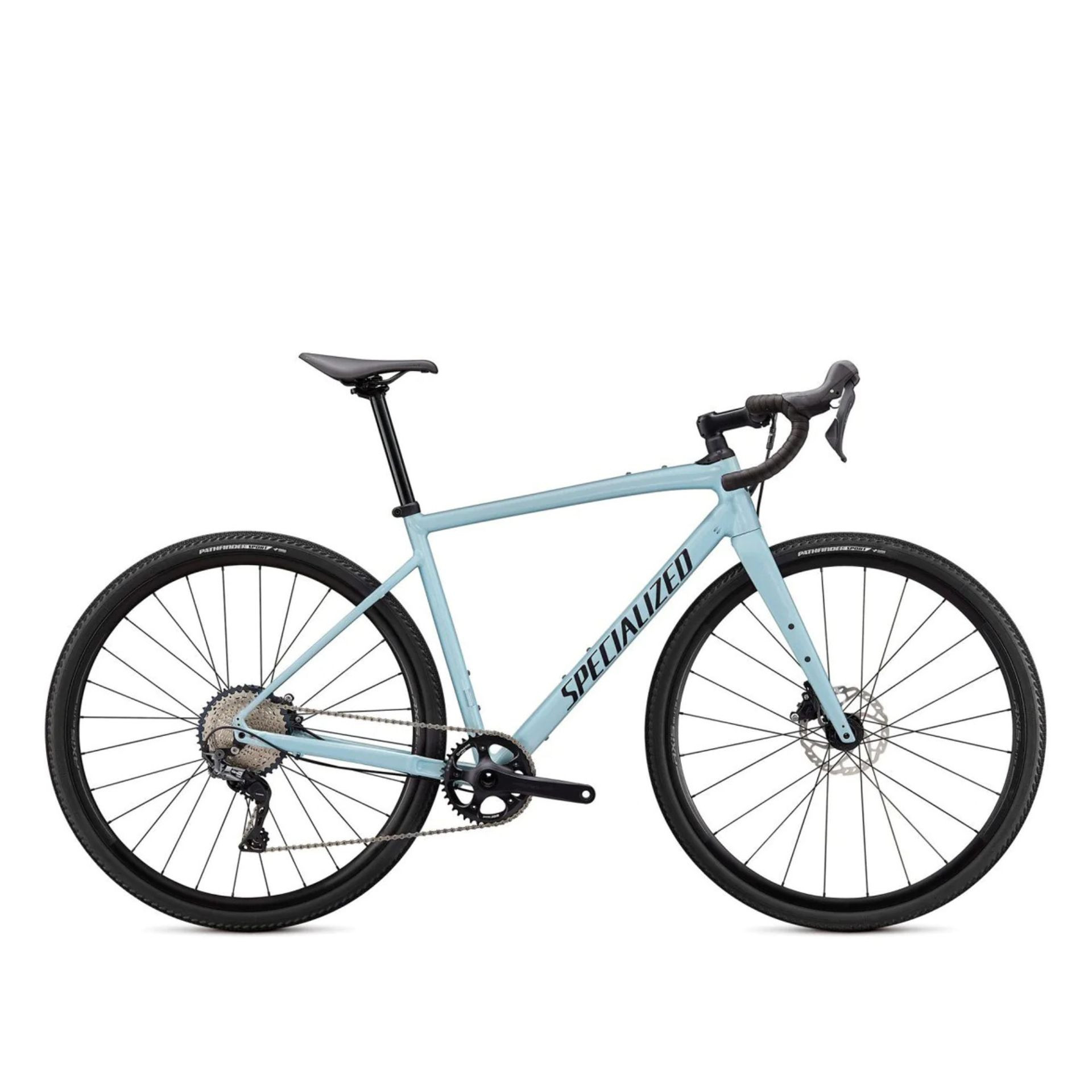 Specialized Diverge E5 Comp gravel bikeThe Specialized Diverge E5 Comp, recognized as the most versatile gravel bike in our 2024 roundup. 2. Specialized Diverge E5 Comp
Specialized Diverge E5 Comp gravel bikeThe Specialized Diverge E5 Comp, recognized as the most versatile gravel bike in our 2024 roundup. 2. Specialized Diverge E5 Comp
Most Versatile Gravel Bike
The Specialized Diverge E5 Comp appeals to long-distance gravel riders with its numerous luggage mounts and relaxed geometry. The Future Shock front suspension enhances comfort and effectively isolates you from trail vibrations, although some riders might find the riding position slightly too upright.
Discover the Specialized Diverge E5 Comp
 Trek Checkpoint SL7 gravel bikeThe Trek Checkpoint SL7, the best gravel bike for bikepacking adventures in 2024. 3. Trek Checkpoint SL7
Trek Checkpoint SL7 gravel bikeThe Trek Checkpoint SL7, the best gravel bike for bikepacking adventures in 2024. 3. Trek Checkpoint SL7
Best Gravel Bike for Bikepacking
The Trek Checkpoint SL7 is well-equipped for multi-day adventures, featuring ample luggage mounts and integrated frame storage for essential spares. Trek’s IsoSpeed decoupler enhances seat tube flex for superior comfort on long off-road days, and the extended wheelbase ensures predictable handling when loaded.
Learn more about the Trek Checkpoint SL7
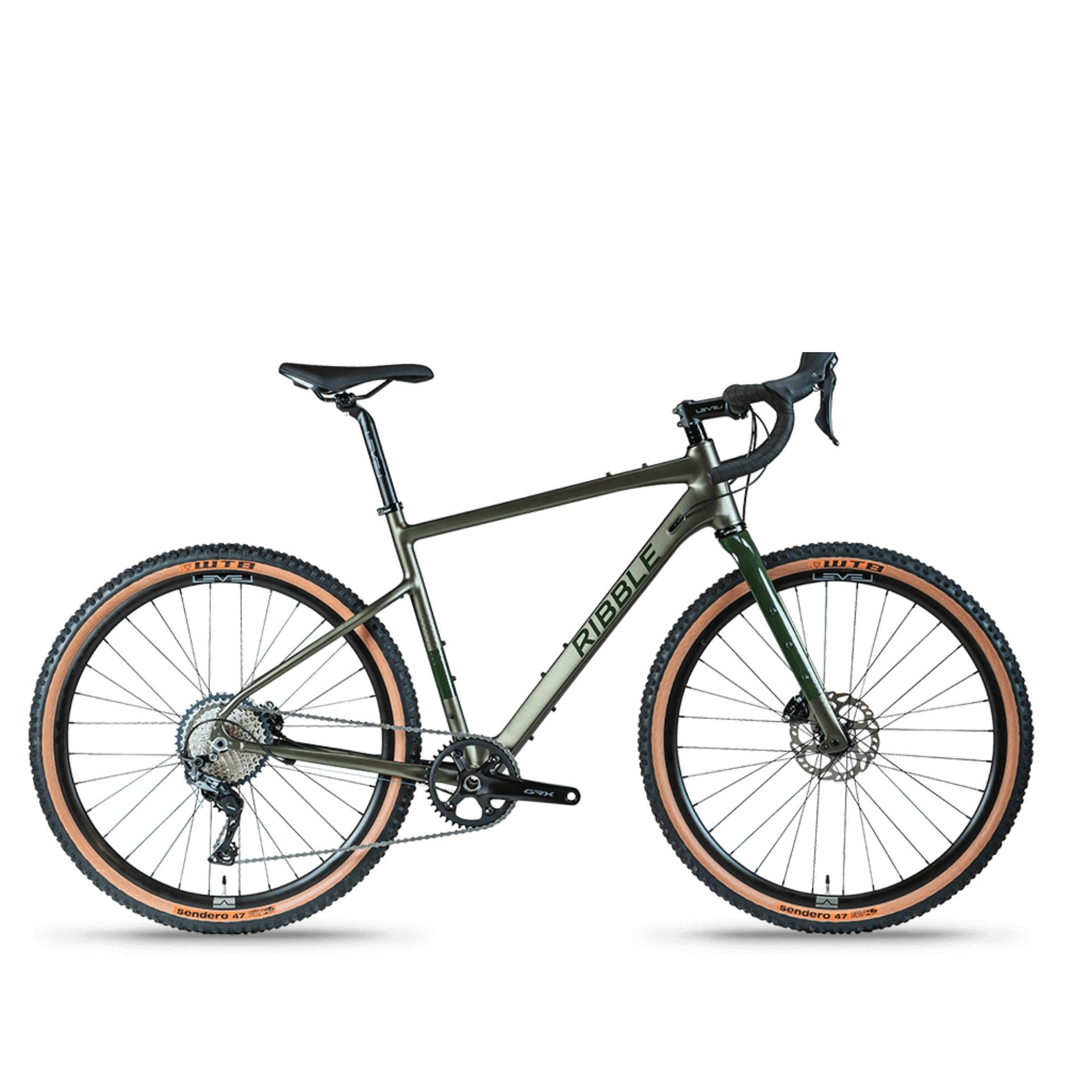 Ribble Gravel AL SportThe Ribble Gravel AL Sport, our top pick for 650b wheel compatibility in a gravel bike. 4. Ribble Gravel AL Sport
Ribble Gravel AL SportThe Ribble Gravel AL Sport, our top pick for 650b wheel compatibility in a gravel bike. 4. Ribble Gravel AL Sport
Best Gravel Bike for 650b Compatibility
Offered with both 700c and 650b wheel options, the Ribble Gravel AL Sport excels as a gravel bike for tackling challenging trails. Its slack head tube angle combined with a long and low geometry provides exceptional stability and off-road capability, while the dependable Shimano GRX 400 groupset delivers reliable performance.
Explore the Ribble Gravel AL Sport
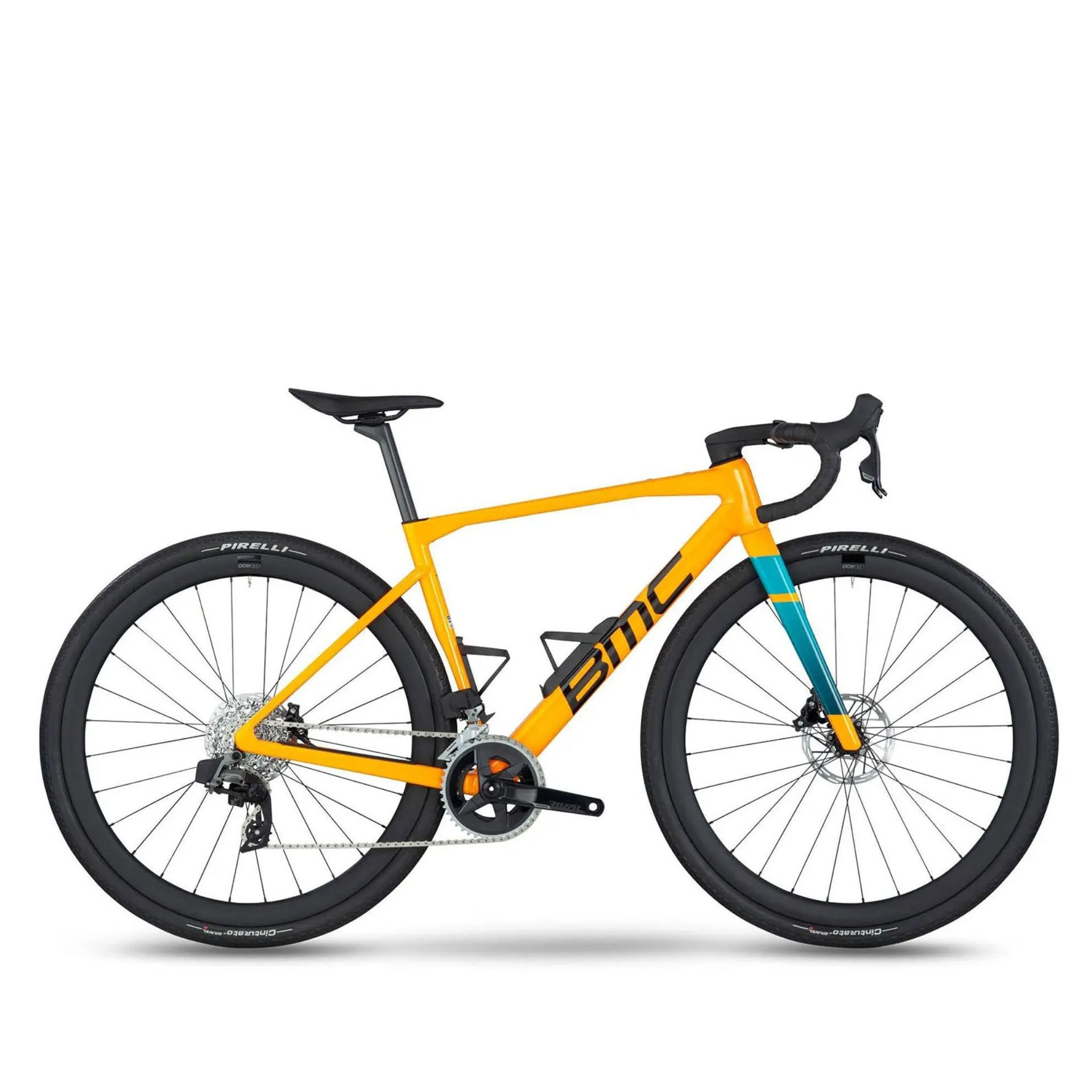 BMC Kaius 01 gravel bikeThe BMC Kaius 01, recognized as the best gravel bike for racing in our 2024 selection. 5. BMC Kaius 01
BMC Kaius 01 gravel bikeThe BMC Kaius 01, recognized as the best gravel bike for racing in our 2024 selection. 5. BMC Kaius 01
Best Gravel Bike for Gravel Racing
The BMC Kaius 01 is designed with racing in mind, featuring an aerodynamic frame and a low, aggressive riding position. While mounting points are minimized, it offers clearance for up to 44mm tires and a short wheelbase for responsive and engaging handling, ideal for gravel race courses.
Best Gravel Bike for Smooth American Style Gravel
As a pioneer in gravel biking, the Salsa Warbird C maintains a focus on simplicity and practicality. This design philosophy results in exceptional comfort and efficiency, making it an excellent choice for smoother gravel terrains where ruggedness isn’t the primary concern.
Learn more about the Salsa Warbird C
BEST GRAVEL BIKES 2024: DETAILED REVIEWS
Best Overall Gravel Bike: Giant Revolt Advanced Pro
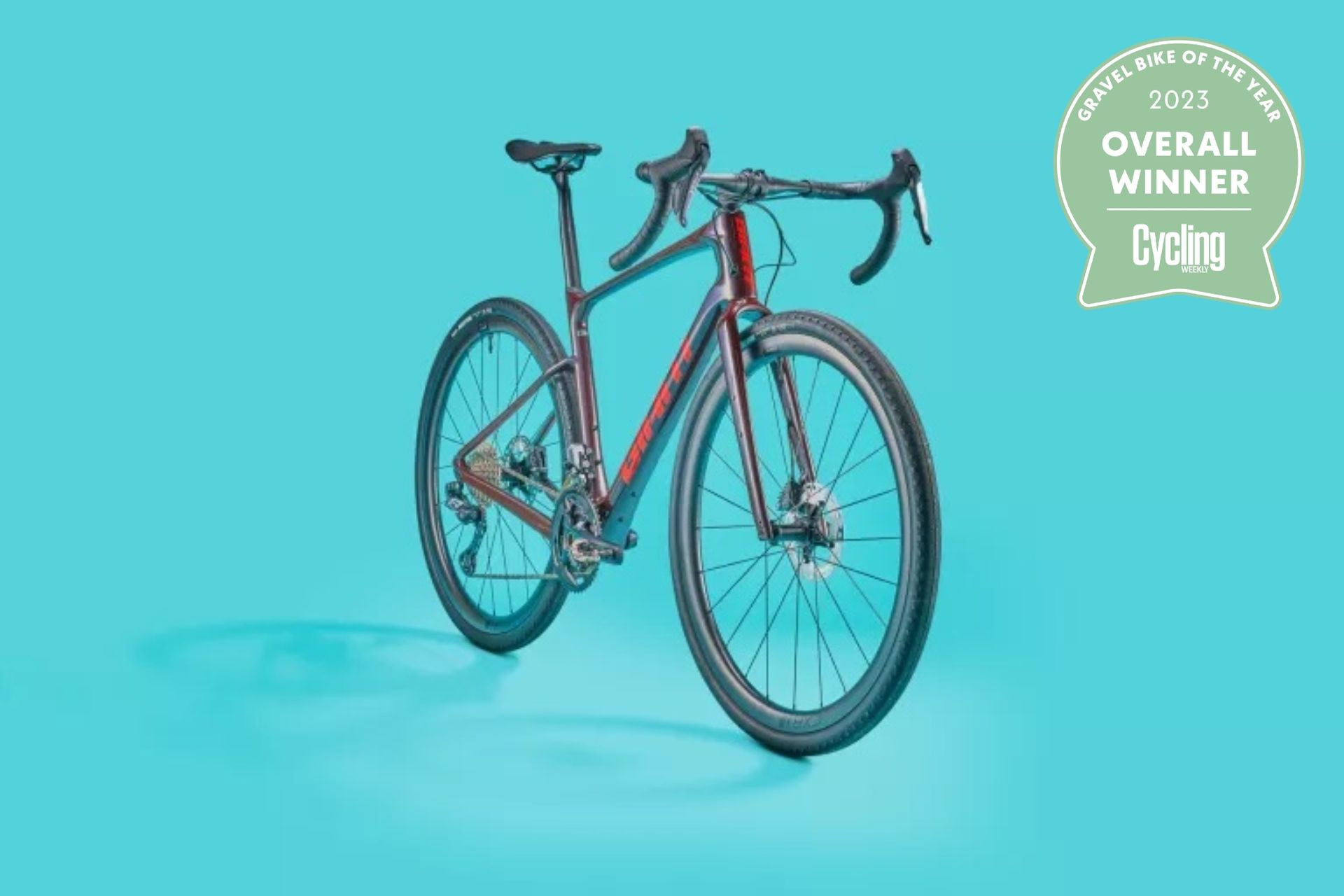 Giant Revolt gravel bike on a blue studio background shot in three quarter viewGiant Revolt Advanced Pro, winner of the Gravel Bike of the Year 2023 award, showcasing its versatile design.
Giant Revolt gravel bike on a blue studio background shot in three quarter viewGiant Revolt Advanced Pro, winner of the Gravel Bike of the Year 2023 award, showcasing its versatile design.
(Image credit: Future)
1. Giant Revolt Advanced Pro
Overall winner of our Gravel Bike of the Year award 2023, the Giant Revolt Advanced Pro excels in versatility and performance.
Read our expert review of the Giant Revolt Advanced Pro
Key Specifications:
- Frame: Advanced SL-Grade Composite carbon frame
- Fork: Advanced-Grade Composite carbon
- Groupset: Shimano GRX RX815 Di2 2x
- Wheels: Giant CXR 1 Carbon
- Tires: Maxxis Receptor, 700x40c
- Weight: 8.3kg
Reasons to Buy:
- Exceptional Comfort: Superb front and rear compliance ensures a comfortable ride, even on rough gravel.
- Adjustable Geometry: Flippable rear dropout allows riders to fine-tune the bike’s geometry for racing agility or enhanced stability.
- Generous Tire Clearance: Accommodates tires up to 53mm, increasing versatility across varied terrains.
Reasons to Consider:
- High Front End: May limit adjustability for riders seeking a more aggressive, lower riding position.
- Dry Condition Tires: Stock Maxxis Receptor tires are optimized for dry conditions and might lack grip in wet or muddy environments.
The Giant Revolt Advanced Pro earned our Gravel Bike of the Year title in 2023 by effectively bridging the diverse needs of gravel riders. Its standout saddle comfort is enhanced by a D-shaped seatpost, engineered with a claimed 12mm of flex. Importantly, it fits a standard 30.9mm round seat tube, offering compatibility with dropper posts for riders tackling more technical gravel trails.
The innovative rear dropouts feature two geometry settings, allowing riders to choose between a more responsive setup for racing or increased tire clearance and stability for challenging terrain. Practicality is also built-in with ample mounting points for bikepacking gear, including on the fork legs, making it ideal for adventure riding.
The frame effectively absorbs bumps and vibrations, both at the front and rear, contributing to its comfortable ride quality. However, some testers noted that a shorter head tube would provide greater versatility in achieving a wider range of riding positions.
We were particularly impressed by the overall value proposition, with the tested specification including Shimano GRX RX815 Di2 electronic shifting and high-performance Giant carbon wheels, components typically found on higher-priced models.
Read the full review: Giant Revolt Advanced Pro 0 gravel bike review
Most Versatile Gravel Bike: Specialized Diverge Comp E5
 Specialized Diverge Comp Carbon, a top versatile gravel bike, ready for adventure.The Specialized Diverge Comp Carbon excels as a versatile gravel bike, capable on diverse terrains.
Specialized Diverge Comp Carbon, a top versatile gravel bike, ready for adventure.The Specialized Diverge Comp Carbon excels as a versatile gravel bike, capable on diverse terrains.
(Image credit: Future)
2. Specialized Diverge Comp E5
Renowned for its adaptability, the Specialized Diverge Comp E5 is a highly popular gravel bike, perfect for riders seeking versatility.
Explore our expert review of the Specialized Diverge Comp E5
Key Specifications:
- Frame: E5 alloy
- Fork: Specialized Future Shock 1.5
- Groupset: SRAM Apex 1×11
- Wheels: AXIS Elite Disc
- Tires: Specialized Pathfinder Sport 38c (Max clearance: 700x47c or 650b x 53 (2.1”))
- Weight: 10.1kg
Reasons to Buy:
- Genre-Spanning Adaptability: Excels across various gravel riding styles, from fast-paced rides to adventurous bikepacking.
- Future Shock Technology: Future Shock 1.5 provides significant front-end comfort and compliance, reducing fatigue on rough surfaces.
Reasons to Consider:
- Compromise Tires: Stock Specialized Pathfinder Sport tires may limit off-road capability in more challenging terrain.
- Relaxed Geometry: Geometry might be less aggressive than preferred for riders focused on high-speed gravel racing.
If your riding leans towards exploration, tackling new trails, embarking on all-day epics, and occasional multi-day bikepacking trips, the Specialized Diverge Comp E5 is an excellent choice. It’s designed with a relaxed geometry and a higher front end, promoting a more comfortable upright riding position. However, we noted that this geometry can make it slightly more challenging to effectively weight the front tire when cornering aggressively.
The Diverge Comp E5 is exceptionally well-equipped for adventure, featuring a comprehensive array of mounts. These include pairs under the down tube and on top of the top tube, as well as triple bosses on the fork legs. It also accommodates full fenders and a pannier rack, catering to riders who prefer traditional luggage-carrying setups for commuting or touring.
A standout feature of the Diverge Comp E5 is the inclusion of Future Shock 1.5, a technology typically reserved for higher-end carbon models. This system effectively dampens trail chatter and high-frequency bumps, significantly enhancing rider comfort. While Future Shock improves comfort, it’s important to note that it’s not intended as a replacement for full front suspension for extremely rugged terrain.
Read the full review: Specialized Diverge Comp Carbon review
Best Gravel Bike for Bikepacking: Trek Checkpoint SL7
 Trek Checkpoint SL7 gravel bike on a blue background, ideal for bikepacking.The Trek Checkpoint SL7 gravel bike, perfectly designed for long-distance bikepacking and adventure.
Trek Checkpoint SL7 gravel bike on a blue background, ideal for bikepacking.The Trek Checkpoint SL7 gravel bike, perfectly designed for long-distance bikepacking and adventure.
(Image credit: Future)
3. Trek Checkpoint SL7
The Trek Checkpoint SL7 offers exceptional stability and comfort, making it the best gravel bike for bikepacking and extended adventures.
Read our expert review of the Trek Checkpoint SL7 gravel bike
Key Specifications:
- Frame: 500 Series OCLV Carbon
- Fork: Checkpoint Carbon
- Groupset: Shimano GRX 2x
- Wheels: WTB ST i23 TCS
- Tires: Vittoria Terreno Dry 700x38c
- Weight: 9.2kg
Reasons to Buy:
- Extensive Mounts and Carrying Capacity: Features a large number of mounts, including fork leg mounts, maximizing luggage and gear carrying options for bikepacking.
- Stable Handling: Wide tire clearance and a long wheelbase provide enhanced stability, crucial for loaded bikepacking setups.
- IsoSpeed Comfort: IsoSpeed seatpost decoupler significantly increases seated comfort on long, rough rides.
Reasons to Consider:
- Premium Price: Positioned at a higher price point compared to some other gravel bikes in its category.
The Trek Checkpoint SL7 is designed with bikepacking in mind, prioritizing mounts and storage. It includes mounts on the fork legs and Trek’s integrated down tube storage for tools and spares, ensuring you can carry everything needed for multi-day adventures. The frame accommodates up to 2.1″ 650b tires, further enhancing its off-road versatility. Trek’s IsoSpeed seat tube decoupler is a key feature, providing noticeable comfort for long days in the saddle.
During our testing, we found that the Checkpoint’s long wheelbase and high fork trail contribute to excellent stability, particularly beneficial when riding fully loaded. Despite its robust carrying capacity, the Checkpoint remains surprisingly agile and responsive, performing well whether fully laden for bikepacking or stripped down for quicker rides.
Our long-term testing affirmed that the Checkpoint SL7 excels as a long-distance gravel machine. Its reassuring handling, comfortable ride quality, and thoughtfully chosen components make it an ideal companion for crushing long miles on varied terrain.
Read the full review: Trek Checkpoint SL 7 gravel bike review
Best Gravel Bike for 650b Compatibility: Ribble Gravel AL Sport
[ Ribble Gravel AL Sport, a top gravel bike under £2000, with Shimano GRX components.Ribble Gravel AL Sport, showcasing its Shimano GRX drivetrain and robust build.
Ribble Gravel AL Sport, a top gravel bike under £2000, with Shimano GRX components.Ribble Gravel AL Sport, showcasing its Shimano GRX drivetrain and robust build.
(Image credit: Future)](https://www.cyclingweekly.com/reviews/bike-reviews/ribble-gravel-al-sport-grx-rx400-review)
4. Ribble Gravel AL Sport
Offering both 700c and 650b wheel size options, the Ribble Gravel AL Sport is a versatile and capable gravel bike, especially for rougher terrains.
Explore our expert review of the Ribble Gravel AL Sport
Key Specifications:
- Frame: Ribble Gravel AL
- Fork: Gravel AL carbon
- Groupset: Shimano GRX RX400 2x
- Wheels: Mavic Allroad
- Tires: WTB Sendero 650b x 47mm
- Weight: 10.9kg
Reasons to Buy:
- Comfortable Wide Tire Ride: Provides a comfortable ride quality, especially when equipped with wide 650b tires.
- Grippy and Capable: Offers ample grip in various conditions, enhancing confidence on diverse terrains.
- Exceptional Value: Represents excellent value for money in the gravel bike market segment.
Reasons to Consider:
- No Rack Mounts: Lacks rack mounts, limiting its suitability for traditional touring or commuting setups requiring panniers.
- Long Reach Geometry: Longer reach geometry might not suit riders with shorter torsos or those preferring a more upright position.
The Ribble Gravel AL Sport is designed to be highly adaptable, offering the choice of 47mm tires on 650b wheels or 700c wheels. The 650b configuration transforms it into a highly capable, go-anywhere gravel bike without a premium price tag.
The alloy frame features a long and low geometry, characterized by a slack headtube, longish reach, and short stem. While it includes numerous mounting points for accessories, it surprisingly omits rack mounts. The Shimano GRX 400 2×10-speed groupset, though entry-level in the GRX range, delivers reliable performance and a wide gear range, including a 30x34t low gear for tackling steep and challenging terrain.
Despite not being the lightest gravel bike, the Ribble Gravel AL Sport feels surprisingly quick and handles well on both poor tarmac and rough gravel tracks. However, we observed a decrease in grip in muddier conditions, suggesting it performs best in drier to mixed conditions.
Read the full review: Ribble Gravel AL Sport review
Best Gravel Bike for Gravel Racing: BMC Kaius 01
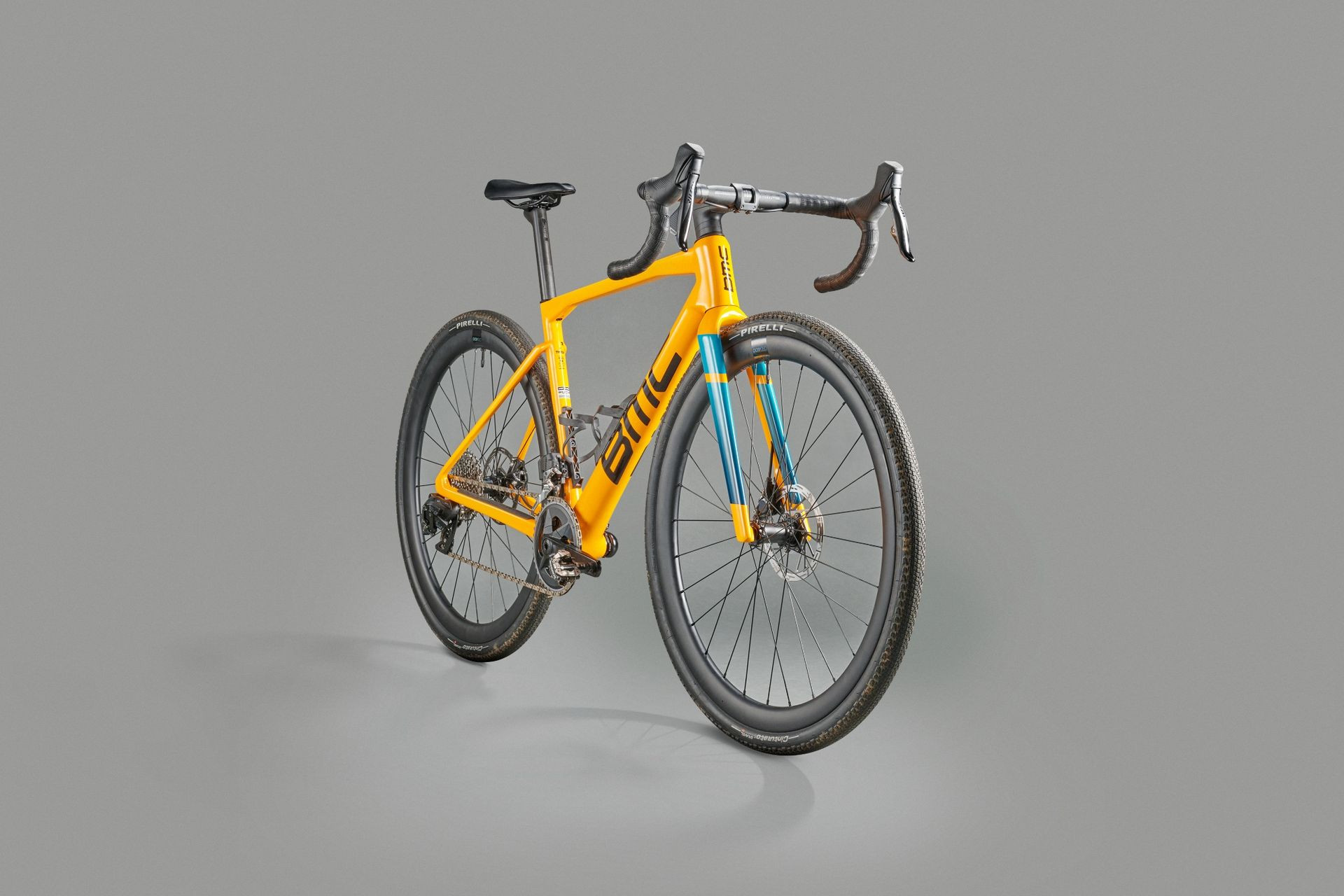 BMC Kaius 01 gravel bike, designed for speed and gravel racing performance.BMC Kaius 01 gravel bike, engineered for uncompromising speed and racing agility.
BMC Kaius 01 gravel bike, designed for speed and gravel racing performance.BMC Kaius 01 gravel bike, engineered for uncompromising speed and racing agility.
(Image credit: Future)
5. BMC Kaius 01
Uncompromisingly focused on speed, the BMC Kaius 01 is the best gravel bike for racers seeking maximum performance.
[Explore our expert insights on the BMC Kaius 01]( )
Key Specifications:
- Frame: Kaius 01 Premium Carbon
- Fork: Kaius 01 Premium Carbon
- Groupset: SRAM Rival AXS Wide 2x
- Wheels: BMC CRD-400 carbon
- Tires: Pirelli Cinturato Gravel H – 40mm
- Weight: 8.9kg
Reasons to Buy:
- Agile and Fast Handling: Offers exceptionally fast and responsive handling, ideal for competitive gravel racing.
- Road Bike Inspired Ride: Delivers a ride feel reminiscent of high-performance road bikes, emphasizing speed and efficiency.
Reasons to Consider:
- Reduced Comfort: Not as comfortable as more endurance-oriented gravel bikes, prioritizing stiffness and responsiveness over long-distance comfort.
- Minimal Mounts: Lacks fender or mudguard mounts, reflecting its race-focused design and reduced versatility for everyday riding or adverse conditions.
Positioned at the opposite end of the gravel spectrum from bikes like the Trek Checkpoint, the BMC Kaius 01 is purpose-built for gravel racing. It features an aggressive, low riding position and an aerodynamic frame design, drawing inspiration from BMC’s Teammachine road race bike.
The ride quality closely mirrors BMC’s road bikes, emphasizing stiffness and direct power transfer. In line with its race focus, mounting points are minimal, even omitting bosses for fenders or mudguards. However, it does provide clearance for up to 44mm tires, which helps to mitigate some of the inherent stiffness of the race-tuned frame.
During our tests, we appreciated the unique combination of a short wheelbase and low bottom bracket, which gives the Kaius snappy, precise handling and impressive speed. This model, equipped with SRAM Rival AXS, offers a more accessible price point compared to the top-tier BMC Kaius models, though it remains more expensive than the highest specification Giant Revolt Advanced Pro.
Read our in-depth review of the BMC Kaius in our Gravel Bike of the Year coverage for a comprehensive analysis.
Best Gravel Bike for Smooth American Style Gravel: Salsa Warbird C
[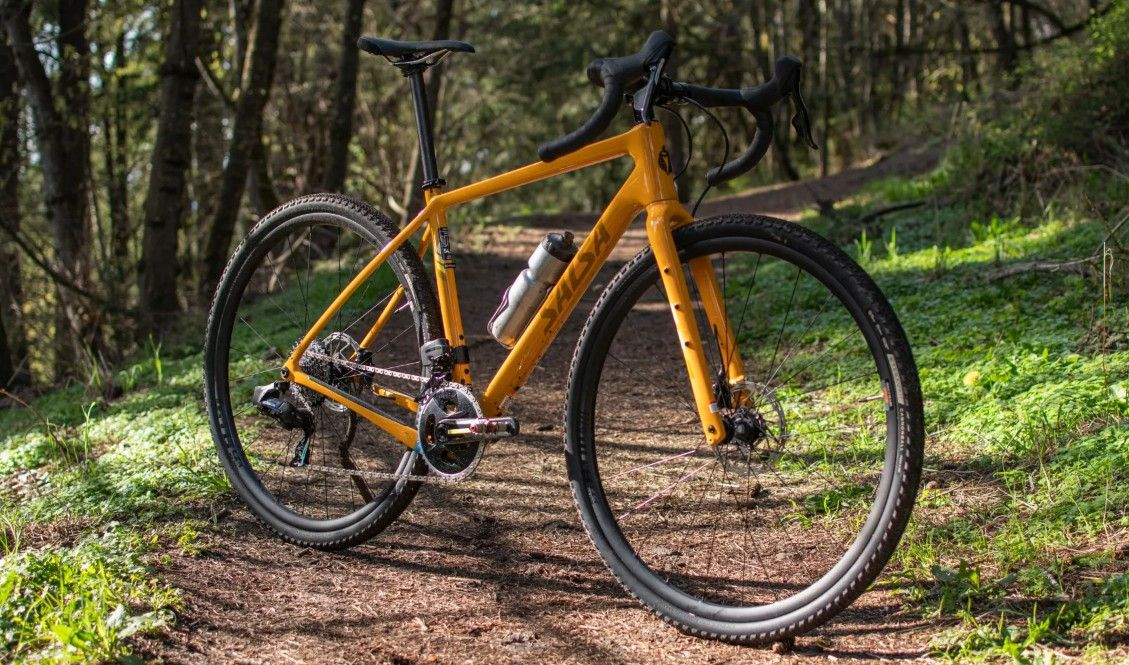 yellow salsa warbird gravel bike sat at an angle on a compact woodland track in a quiet wooded areaSalsa Warbird C Sram Force AXS XPLR, designed for smooth transitions from road to gravel.
yellow salsa warbird gravel bike sat at an angle on a compact woodland track in a quiet wooded areaSalsa Warbird C Sram Force AXS XPLR, designed for smooth transitions from road to gravel.
(Image credit: Future)](https://www.cyclingweekly.com/reviews/road-bikes/salsa-warbird-c-review-a-gravel-race-bike-for-the-people)
6. Salsa Warbird C
The Salsa Warbird C ensures seamless transitions from paved roads to gravel, making it ideal for varied terrains and smooth gravel riding styles.
Read our expert review of the Salsa Warbird C gravel bike
Key Specifications:
- Frame: Class 5™ VRS-equipped high-modulus carbon fiber
- Fork: Salsa Waxwing Deluxe
- Groupset: Sram Force eTap AXS
- Wheels: WTB CZR i23 carbon rim on DT Swiss 370 hubs
- Tires: Teravail Cannonball 700c x 42mm, Durable casing, tubeless-ready
- Weight: 9.1kg
Reasons to Buy:
- Long-Distance Comfort: Engineered for comfort over long distances, making it suitable for endurance gravel rides.
- Wheel Size Versatility: Compatible with both 700c and 650b wheel sizes, offering flexibility for different riding preferences and terrains.
- Ample Luggage Mounts: Features plenty of luggage mounting points, enhancing its capability for bikepacking and adventure riding.
- Frame-Only Option: Available as a frame-only option, allowing for custom builds to meet specific rider needs and component preferences.
Reasons to Consider:
- Premium Stock Spec Price: Stock specification pricing tends to be on the higher side, which may be a consideration for budget-conscious buyers.
- Press-Fit Bottom Bracket: Utilizes a press-fit bottom bracket, which some mechanics and riders find less desirable compared to threaded bottom brackets.
- Narrower Tire Clearance: 42mm tire clearance is somewhat narrow by modern gravel bike standards, potentially limiting its performance in very muddy or extremely rough conditions.
Salsa is a foundational brand in modern gravel biking, with the Warbird first launched in 2012. Inspired by the adoption of disc brakes in cyclocross, the Warbird has consistently shaped the evolution of gravel bikes. Now in its 4th generation, it remains a benchmark.
Despite its last major update in 2019, the Warbird maintains its relevance. In a market increasingly focused on aerodynamics and complex compliance systems, the Warbird retains a refreshing simplicity, emphasizing frame design and ride quality. We found the Warbird to be remarkably capable, transitioning seamlessly from tarmac to gravel and effectively smoothing out rough sections, provided they are not excessively challenging.
The frame-only option of the Warbird offers exceptional value, allowing riders to invest in components that significantly enhance the bike’s performance. In our previous review, we built up a Warbird with SRAM Apex AXS, a budget-friendly wireless groupset, along with Hunt 40 CGR Carbon wheels and an Ergon Allroad Carbon Post, creating a fast and comfortable gravel machine.
Read the full review: Salsa Warbird C review
Best All-Round Performance Gravel Bike: Scott Addict Gravel 10
 Scott Addict Gravel bike on a blue background, highlighting its performance.Scott Addict Gravel 10, offering excellent all-around performance and value.
Scott Addict Gravel bike on a blue background, highlighting its performance.Scott Addict Gravel 10, offering excellent all-around performance and value.
(Image credit: Future)
7. Scott Addict Gravel 10
A superb all-round performance gravel bike, the Scott Addict Gravel 10 balances speed, handling, and value effectively.
Key Specifications:
- Frame: Addict Gravel Disc HMF Carbon
- Fork: Addict Gravel HMF Carbon
- Groupset: SRAM Force AXS 2x
- Wheels: DT Swiss GRC1400 Disc
- Tires: Schwalbe G-One Bite Performance 45mm
- Weight: 8.7kg
Reasons to Buy:
- Balanced Ride Position: Offers a middle-of-the-road riding position, suitable for both performance and endurance.
- Value for Specification: Provides good value for the components and performance offered at its price point.
- Attractive Aesthetics: Features a superb paint job, enhancing its visual appeal.
Reasons to Consider:
- No Fork Mounts: Lacks fork leg mounts, limiting front luggage carrying options for extensive bikepacking setups.
The Addict Gravel is engineered for speed and performance, yet it’s more versatile than dedicated gravel race bikes like the BMC Kaius. It features a longer wheelbase and higher stack, resulting in a balanced ride that excels in fast, technical riding as well as multi-day bikepacking, despite the absence of fork leg mounts.
We particularly appreciated the Scott Addict Gravel’s striking paint finish. It also offers excellent value, with the SRAM Rival AXS-equipped model priced competitively against brands typically known for value-oriented offerings.
Read our detailed assessment of the Scott Addict Gravel 10 in our Gravel Bike of the Year coverage for a deeper dive.
Most Composed Gravel Bike: Cannondale Topstone Carbon 3
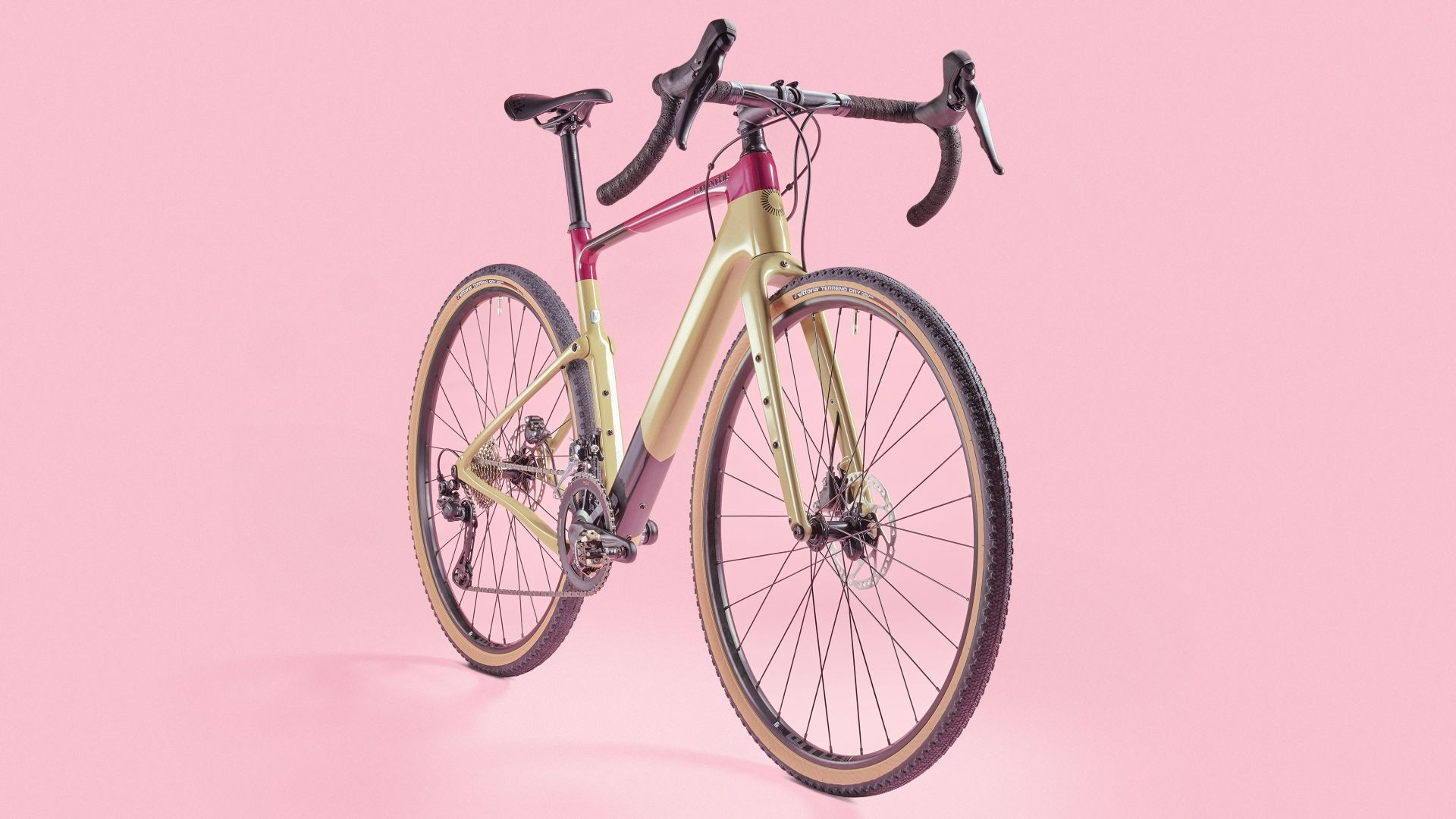 Cannondale Topstone carbon three on pink background, highlighting its Kingpin suspension.Cannondale Topstone Carbon 3, featuring Kingpin suspension for a composed ride.
Cannondale Topstone carbon three on pink background, highlighting its Kingpin suspension.Cannondale Topstone Carbon 3, featuring Kingpin suspension for a composed ride.
(Image credit: Richard Butcher)
8. Cannondale Topstone Carbon 3
The Cannondale Topstone Carbon 3 offers the most composed rear end in its class, with options for full suspension, enhancing comfort and control.
Explore our expert review of the Cannondale Topstone Carbon 3
Key Specifications:
- Frame: BallisTec Carbon Frame
- Fork: BallisTec Carbon
- Groupset: Shimano GRX 2x
- Wheels: WTB ST i23 TCS 650
- Tires: Vittoria Terreno Dry 38mm
- Weight: 9.2kg
Reasons to Buy:
- Advanced Suspension Frame: Excellent frame with 30mm of rear travel provided by Cannondale’s Kingpin suspension system, enhancing comfort and control.
- Enhanced Traction: Provides good traction on rough and loose terrain due to the rear suspension system.
- Smart Sense Option: Offers the option to integrate Cannondale’s Smart Sense lighting and radar system for added safety and visibility.
Reasons to Consider:
- Front-End Comfort Discrepancy: Front-end comfort may not fully match the plushness of the rear suspension, leading to a slightly unbalanced feel in very rough conditions.
The Cannondale Topstone Carbon presents geometry that appears aggressive on paper, yet it delivers a more forgiving ride than expected. It incorporates Cannondale’s Kingpin rear suspension, now simplified for reduced weight. This pivotless design offers 30mm of travel, significantly improving rear-wheel traction on rough terrain, although it does not directly enhance front-end comfort. For riders seeking front suspension, the Topstone Carbon Lefty model with a suspension fork is available.
The Topstone Carbon 3 offers the option to include Cannondale’s Smart Sense system, featuring integrated lighting and rearview radar, enhancing safety and awareness. Cannondale maintains competitive pricing despite the advanced frame technology and features included.
Our tests concluded that the Topstone Carbon 3 delivers “a sublime blend of exuberance, speed and comfort”, offering a poised and playful ride. Its versatility extends to bikepacking, accommodating overnight gear thanks to multiple mounting points.
Read the full review: Cannondale Topstone Carbon 3 review
Best Lightweight Gravel Bike: Specialized Crux Pro
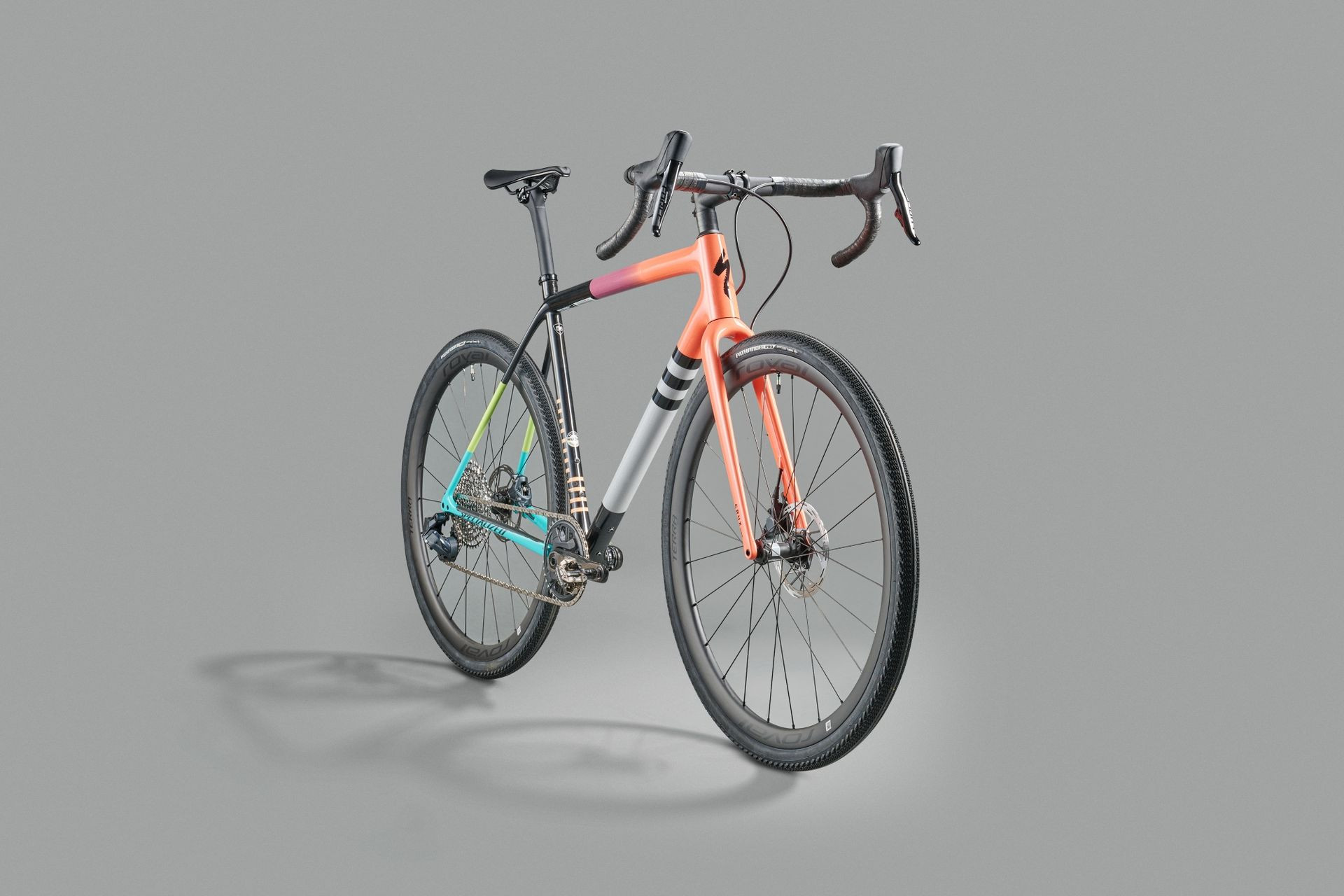 Specialized Crux Pro gravel bike, lightweight and ready for racing.Specialized Crux Pro, a lightweight gravel bike built for racing and speed.
Specialized Crux Pro gravel bike, lightweight and ready for racing.Specialized Crux Pro, a lightweight gravel bike built for racing and speed.
(Image credit: Future)
9. Specialized Crux Pro
A lightweight racer, the Specialized Crux Pro blurs the lines between cyclocross and gravel, making it the best choice for lightweight performance.
Read our expert review of the Specialized Crux Pro gravel bike
Key Specifications:
- Frame: Crux FACT 10r Carbon
- Fork: FACT Carbon
- Groupset: SRAM Force AXS
- Wheels: Roval Terra CL
- Tires: Pathfinder Pro 38mm
- Weight: 7.4kg
Reasons to Buy:
- Lightweight and Responsive: Features a lightweight and highly responsive frameset, ideal for racers and performance-oriented riders.
- Agile and Fast Ride: Delivers an agile and fast ride quality, excelling in acceleration and quick handling.
- 650b Compatibility: Offers clearance for up to 2.1″ 650b tires, increasing versatility for varied terrains.
Reasons to Consider:
- Jittery Ride on Rough Surfaces: May feel jittery on very rough surfaces when equipped with the stock 38mm tires, due to its lightweight and stiff frame.
Priced more accessibly than the S-Works Crux, the Crux Pro maintains a very light weight and shares the same responsive geometry as its top-spec sibling. This results in exceptionally quick acceleration, although the stock 38mm tires can lead to a somewhat jittery ride on rougher terrain.
To enhance comfort and traction, riders can opt for wider 2.1″ 650b tires. The Crux Pro also features a round seatpost, allowing for the installation of a dropper post or suspension seatpost for increased versatility.
We believe the Crux Pro is ideally suited for riders who prioritize agile performance on gravel, seeking a bike that’s capable of high speeds and efficient power transfer.
Read the full review: Specialized Crux Pro review
Best Custom Build Gravel Bike Option: Enve MOG
[ Alexey Vermeulen on his custom Enve MOG gravel bike.Alexey Vermeulen showcasing his custom-built Enve MOG gravel bike.
Alexey Vermeulen on his custom Enve MOG gravel bike.Alexey Vermeulen showcasing his custom-built Enve MOG gravel bike.
(Image credit: ENVE Composites)](https://www.cyclingweekly.com/reviews/bike-reviews/the-enve-mog-a-first-ride-review-of-the-american-brands-first-foray-into-gravel)
10. Enve MOG
For those looking to personalize every detail, the Enve MOG stands out as the best gravel bike for custom builds, offering unparalleled personalization.
Explore our expert first ride review of the Enve MOG
Key Specifications:
- Frame: ENVE M.O.D Carbon
- Fork: ENVE M.O.D Carbon
- Frame Weight: 950g
- Frame Kit Includes: Frame, fork, handlebar, stem, headset, and seatpost
Reasons to Buy:
- Balanced Geometry: Offers well-balanced geometry, suitable for a wide range of gravel riding styles and terrains.
- Lightweight and Durable: Lightweight construction without compromising durability, ensuring performance and longevity.
- Extensive Mounts and Storage: Features numerous mounts and downtube storage, enhancing its bikepacking and adventure capabilities.
- User-Friendly Features: Includes a threaded BB and a round seat tube, appreciated for their reliability and ease of maintenance.
- Generous Tire Clearance: Provides ample tire clearance, accommodating wide gravel tires for enhanced comfort and traction.
Reasons to Consider:
- Chassis-Only Option: Available as a chassis-only option, requiring separate component selection and build, which may not be ideal for all buyers.
- 700c Wheel Focus: Engineered specifically around 700c wheels, potentially limiting appeal for riders preferring 650b setups.
- Fixed Geometry: Lacks geometry adjustment features, which some riders might desire for fine-tuning ride characteristics.
Enve has built a reputation for exceptional quality and high-performance cycling components, many of which are manufactured in the USA. The MOG is Enve’s second complete bike offering, following the acclaimed Melee road bike launched in 2022.
The MOG incorporates all the essential features of modern gravel bikes, including generous tire clearance, frame storage, and abundant mounts. While priced at a premium, the MOG offers considerable value for a brand synonymous with high design, engineering, and quality. The frame kit includes a frame, fork, headset, stem, handlebar, and seatpost, aligning with brands like Trek and Specialized, despite Enve’s smaller scale of production.
The MOG truly shines on dirt. We found it strikes an excellent balance between stiffness and comfort. While not designed for outright sprints, it maintains pace effectively and provides a comfortable ride. The slack geometry inspired confidence on descents, a trait particularly appealing to riders planning to load up for bikepacking adventures.
Read More: Enve MOG first ride review
Gravel Bikes: Essential Guide for 2024
What Exactly Are Gravel Bikes?
Gravel bikes are more than just drop-bar bikes; some brands now offer flat-bar versions to broaden their appeal. In essence, gravel bikes are designed to confidently transition from paved roads to varied terrains.
Born for adventure, the best gravel bikes blend characteristics of endurance road bikes, cyclocross bikes, and even hardtail mountain bikes. They offer agility on pavement compared to mountain bikes, yet inspire greater confidence on rough surfaces than road bikes.
Key features of top gravel bikes include wider tires for enhanced traction and comfort, ample mud clearance, and disc brakes as standard. Tire widths typically range from 35c to 50c or more, available on both 700c and 650b wheels.
Practicality is also a hallmark, with mounts for bottle cages, pannier racks, and fenders commonly included, expanding their utility for commuting, touring, and everyday riding.
Finding the right fit is crucial, regardless of gender. For women’s specific gravel bikes, often featuring smaller frame sizes and contact point adjustments like wider saddles and narrower handlebars, explore our guide to the best women’s gravel bikes for off-road adventures.
For budget-conscious riders, our guide to the best budget gravel bikes under £1,000/$1500 highlights models that offer similar handling to premium bikes but with more economical components, making gravel riding accessible to more cyclists.
The versatility of gravel riding also extends to gear. Navigating the Lycra vs. non-Lycra debate? Our guide on the best gravel bike clothing provides insights into selecting the right cycling kit for your gravel adventures.
Road Performance of Gravel Bikes: Are They Efficient?
Compared to dedicated road bikes, gravel bikes typically feature wider tires and lower gear ratios. These wider, lower gears are beneficial for tackling loose surfaces and steep inclines, especially when carrying bikepacking bags for multi-day expeditions.
Gravel bikes generally have a lower bottom bracket than cyclocross bikes, enhancing stability on challenging terrain with rocks, roots, and uneven surfaces. For a detailed comparison, our article on gravel vs cyclocross bikes: what is the difference provides valuable insights.
For riders seeking to venture off-road without sacrificing speed, electric gravel bikes offer an appealing option. Electric gravel bikes combine all-terrain capability with the added assistance of electric power, making challenging rides more accessible and enjoyable.
Why the Popularity of Gravel and Adventure Bikes?
If you’ve ever ridden your road bike and been intrigued by unpaved roads or trails, gravel bikes open up new possibilities. They bridge the gap between on-road efficiency and off-road capability, incorporating design elements from road, cyclocross, and mountain bikes. When choosing your first gravel bike, expect standard features like disc brakes and clearance for wider tires.
While cyclocross bikes are designed for short, intense races, gravel and adventure bikes cater to longer rides on unpaved surfaces. The gravel category includes race-oriented builds for competitive events and adventure models with extra clearance and mounts for luggage, accommodating even wider tires for remote expeditions.
Frame and Fork Materials: Does It Matter for Gravel Bikes?
Gravel bike frames, similar to road bikes, are constructed from various materials including carbon, aluminum, titanium, and steel.
Carbon and aluminum are the most common choices. Carbon frames are typically lighter and more expensive, while aluminum frames are more affordable and durable, albeit heavier. For a comparable price, aluminum-framed bikes often offer higher-spec components than carbon models.
Carbon fiber’s key advantage is its versatility in frame design. It can be strategically added for strength and stiffness or removed to reduce weight and fine-tune compliance, optimizing ride characteristics.
Titanium gravel bikes are less common but prized for their lively ride quality, combining light weight and high strength. High-end steel frames offer a ride quality similar to titanium, with a slight weight increase, while entry-level steel gravel bikes provide durability and repairability advantages over aluminum.
Regardless of frame material, most gravel bikes utilize carbon forks. Carbon forks can be engineered to dampen trail vibrations, crucial for front-end comfort on rough terrain.
Gravel Bike Geometry vs. Road Bikes: Key Differences
Stability and responsive handling are paramount for off-road riding. Gravel bike geometry typically includes a longer wheelbase, slacker head tube angle, and lower bottom bracket compared to road bikes. These adjustments enhance control on technical terrain and during steep descents.
Rider position on gravel bikes is generally more upright than on road bikes. This upright posture improves comfort for long rides and allows for greater rider movement to navigate off-road obstacles effectively.
 Gravel bike fork with thru-axle and hydraulic disc brakesClose-up of a gravel bike fork featuring a 12mm thru-axle and hydraulic disc brakes, essential for off-road performance.
Gravel bike fork with thru-axle and hydraulic disc brakesClose-up of a gravel bike fork featuring a 12mm thru-axle and hydraulic disc brakes, essential for off-road performance.
(Image credit: Future)
Specialized Features of Gravel Bikes: Beyond the Basics
Thru-axles and disc brakes are now standard on gravel bikes, technologies adopted from mountain biking. While less common, some gravel bikes also incorporate front and rear suspension systems for enhanced comfort and control.
12mm thru-axles are the norm, improving disc brake alignment and overall wheel rigidity. Rear-axle spacing for disc brake wheels is typically 142mm (thru-axle), or sometimes 148mm Boost spacing for increased wheel strength.
Adventure and utility-focused gravel frames often include mounts for racks and fenders, transforming the bike into a capable commuter or year-round road bike. At the more extreme end of adventure biking, fork leg mounts and additional frame mounts are increasingly common, maximizing luggage carrying capacity for extended expeditions.
Gravel Bike Components: Tailoring to Terrain
A wide array of specialized gravel bike components enhance performance and versatility beyond standard road bike parts. Here are key component considerations for gravel riding:
Best Tires for Gravel and Adventure Bikes: Grip and Rolling Resistance
Gravel and adventure bikes are equipped with a wide range of tire widths, from 28c to 47c, and even wider inch-based sizes on 650b wheel setups.
The best gravel bike tires significantly impact ride quality and performance. Available tread patterns vary widely, from aggressive treads for muddy conditions to low-rolling resistance designs for mixed surfaces.
Upgrading tires is one of the most impactful gravel bike upgrades. Opting for tubeless tires is also highly recommended to improve comfort and reduce puncture risks.
In regions with frequent wet mud and loose dirt, more aggressive tire treads enhance grip, though they might slightly increase rolling resistance on paved surfaces.
However, gravel road conditions vary greatly. In some areas, gravel roads resemble smooth tarmac, while others are rougher, like the limestone gravel found in Kansas.
Experimenting with different tire types is key to finding the best setup for your local terrain. Consider using different tires for summer and winter to optimize performance across seasons.
Most gravel bikes come with tubeless-ready tires and rims, easily convertible to tubeless setups. Tubeless systems use sealant to automatically plug punctures, a significant advantage for off-road riding, minimizing flats and maintaining momentum.
While sealant handles many punctures, carrying tubeless tire plugs and a spare tube is essential for more significant tire damage.
Gearing Options for Gravel and Adventure Bikes: Finding the Right Range
Gravel and adventure bikes are designed for both on and off-road riding, requiring a wide gear range. This range ensures efficiency and speed on pavement and sufficient low gears for steep, loose off-road climbs.
The choice between 1x (single chainring) and 2x (double chainring) front drivetrain setups depends on rider preference and terrain. 1x drivetrains offer simplicity and increased tire clearance, but may have wider gaps between gears. Modern 12 and 13-speed groupsets mitigate these gaps.
2x drivetrains provide more gear options, preferred by riders who spend more time on smoother terrain or roads. They offer a broader overall range with smaller steps between gears, useful for maintaining cadence on varied gradients.
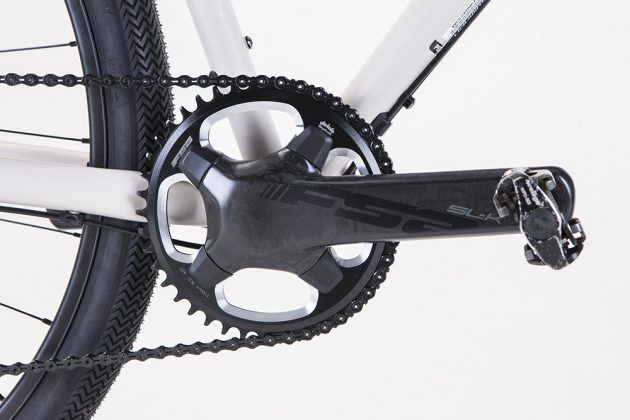 Best gravel and adventure bikes showcasing a 1X drivetrain for simplicity.A 1X drivetrain on a gravel bike, emphasizing simplicity and ample rear tire clearance.
Best gravel and adventure bikes showcasing a 1X drivetrain for simplicity.A 1X drivetrain on a gravel bike, emphasizing simplicity and ample rear tire clearance.
Gravel bike gearing often includes ratios lower than 1:1 for challenging climbs and loaded riding. 1x systems like SRAM XPLR with cassettes up to 42 teeth or more, or 2x supercompact chainsets with 48/32 or 46/30 chainrings paired with 11-32 or 11-34 cassettes achieve these low ratios. “Mullet builds” combine road chainsets with MTB cassettes and rear derailleurs for ultra-low gearing, sometimes reaching as low as 38x52t.
Refer to our comprehensive guide on gravel bike gearing to learn more about choosing the right setup for your riding style and terrain.
Pedal Choices for Gravel and Adventure Bikes: Clipless or Flat?
Pedal selection depends on personal preference and riding style. Our guide to the best gravel bike pedals offers detailed advice. For predominantly road and well-maintained path riding, road cycling shoes and clipless pedals are efficient.
For more demanding off-road riding, requiring frequent dismounting or foot-down stability, gravel bike shoes and two-sided gravel bike pedals are more suitable. These systems, derived from mountain biking, feature grippy soles and recessed cleats for easier walking and pedal engagement.
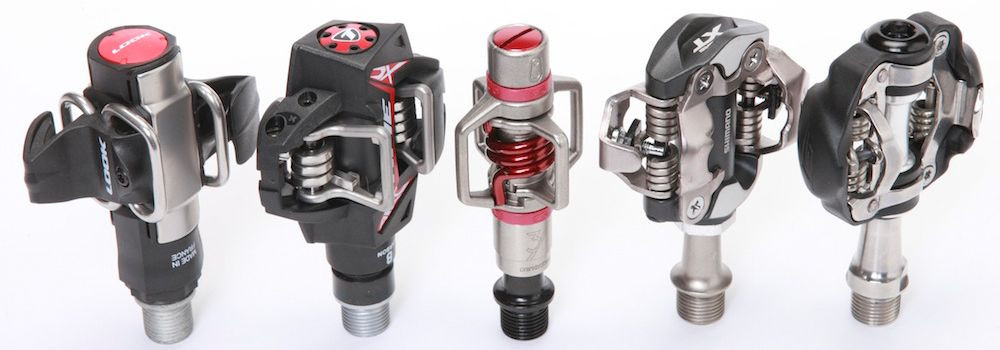 Best gravel and adventure bikes with mountain bike style pedals for off-road versatility.Mountain bike style pedals on a gravel bike, facilitating easier walking, mounting, and dismounting on varied terrain.
Best gravel and adventure bikes with mountain bike style pedals for off-road versatility.Mountain bike style pedals on a gravel bike, facilitating easier walking, mounting, and dismounting on varied terrain.
Essential Components on the Best Gravel Bikes: What to Expect
Adventure and gravel bikes utilize disc brakes for superior modulation and consistent stopping power in diverse conditions. Disc brakes also extend wheel rim lifespan, especially beneficial for off-road riding.
Higher-end models typically feature hydraulic disc brakes, while budget gravel bikes often use mechanical disc calipers. Shimano GRX and SRAM gravel-specific groupsets primarily offer hydraulic disc options, reflecting their performance advantages. Mechanical disc brakes are sometimes found on adventure bikes, favored by long-distance riders for their simpler maintenance and repair in remote locations.
Handlebar selection is another key component consideration. Our guide to the best gravel bike handlebars provides further insights. Flared handlebars are a popular upgrade, offering increased stability in the drops for rough terrain and descents. Wider flares also accommodate handlebar bags while still allowing hand placement on the drops and brakes. Raised handlebars, such as the Specialized Hover Bar, improve front wheel clearance for smaller riders and provide a more upright riding posture.
 The Giant Revolt X Advanced Pro 0 gravel bike with dropper post and suspension fork.The Giant Revolt X Advanced Pro 0 equipped with a dropper post and suspension fork, showcasing advanced gravel bike features.
The Giant Revolt X Advanced Pro 0 gravel bike with dropper post and suspension fork.The Giant Revolt X Advanced Pro 0 equipped with a dropper post and suspension fork, showcasing advanced gravel bike features.
(Image credit: Giant)
Short-travel suspension forks, like the RockShox Rudy Ultimate XPLR and Cannondale Lefty Oliver, are increasingly integrated into gravel bike designs, enhancing comfort and control on challenging terrain.
How We Test Gravel Bikes: Rigorous and Real-World
The Cycling Weekly testing team rigorously evaluates a wide range of cycling products, providing objective reviews based on extensive real-world use across diverse conditions.
Our experienced testers compare products, identify strengths and weaknesses, and deliver unbiased assessments of performance.
Gravel bike testing involves logging significant miles across varied routes, from technical mountain bike trails to multi-day bikepacking adventures, and everything in between. We also assess bikes on paved roads, acknowledging that many riders use gravel bikes for commuting and winter riding, and that most gravel rides include some tarmac sections.
During testing, we evaluate bikes on comfort, handling, suitability for various gravel terrains and bikepacking, component quality and durability, and overall value for money.

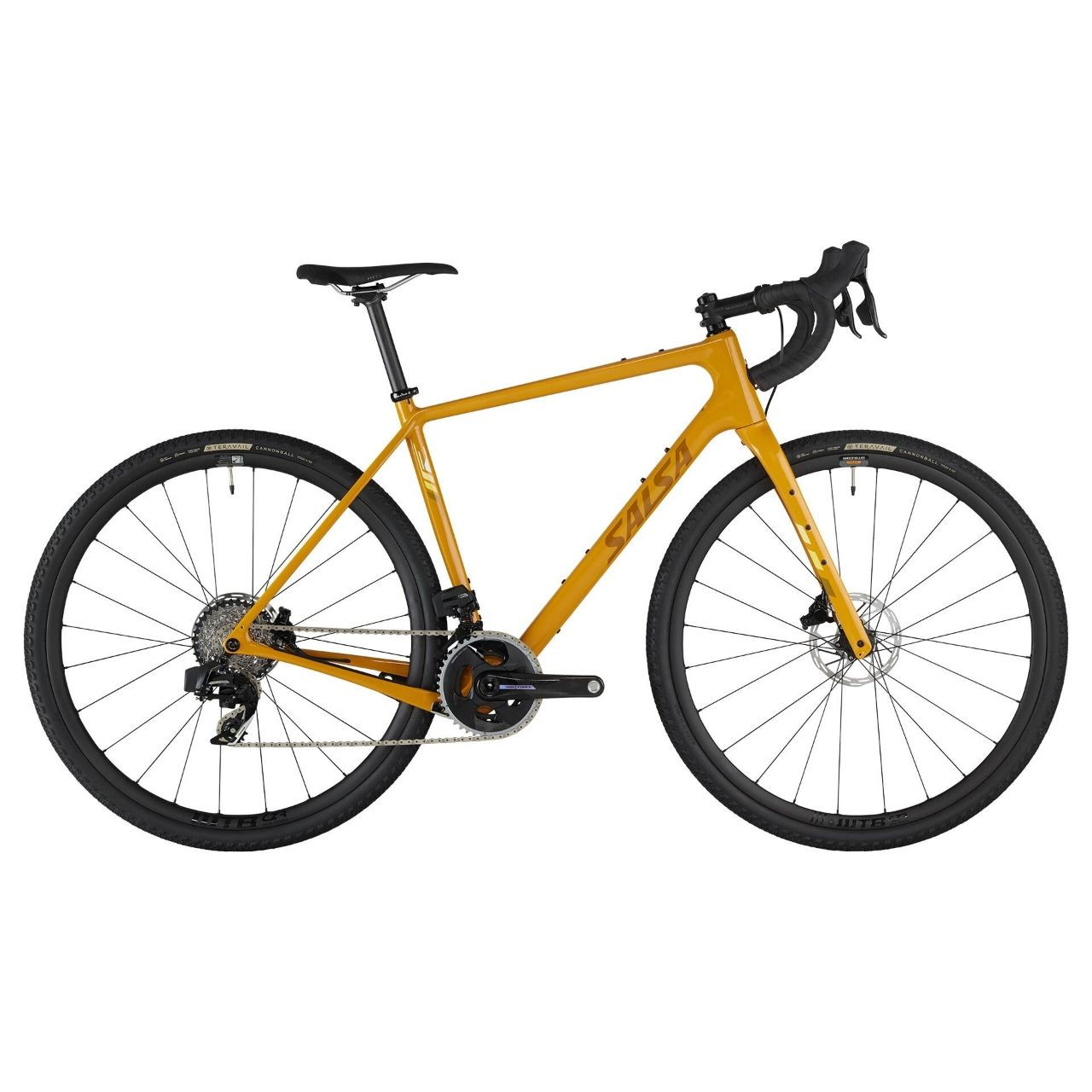 a yellow salsa warbird gravel bike fitted with sram force axs and carbon fibre wheels on a white studio backgroundThe Salsa Warbird C, acclaimed as the best gravel bike for smooth, American-style gravel riding.
a yellow salsa warbird gravel bike fitted with sram force axs and carbon fibre wheels on a white studio backgroundThe Salsa Warbird C, acclaimed as the best gravel bike for smooth, American-style gravel riding.